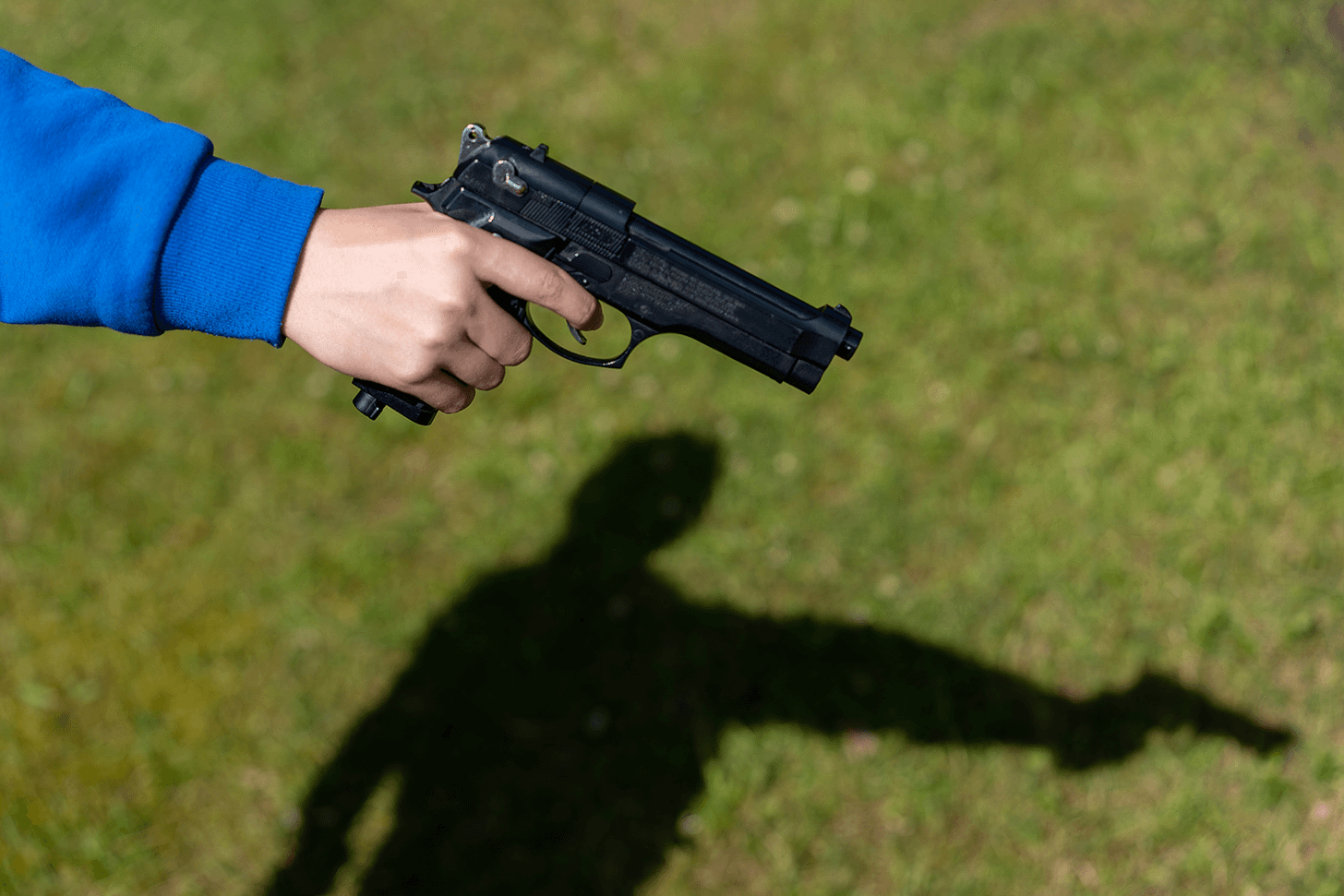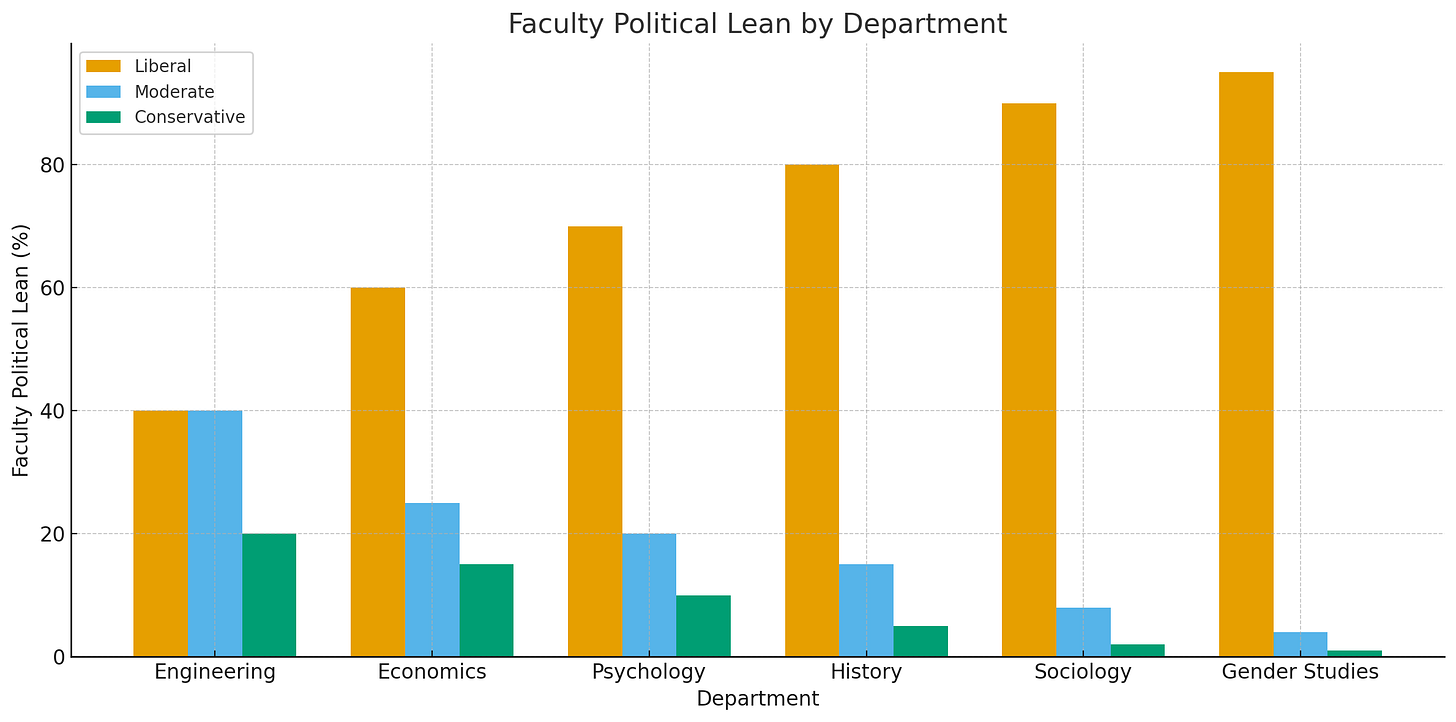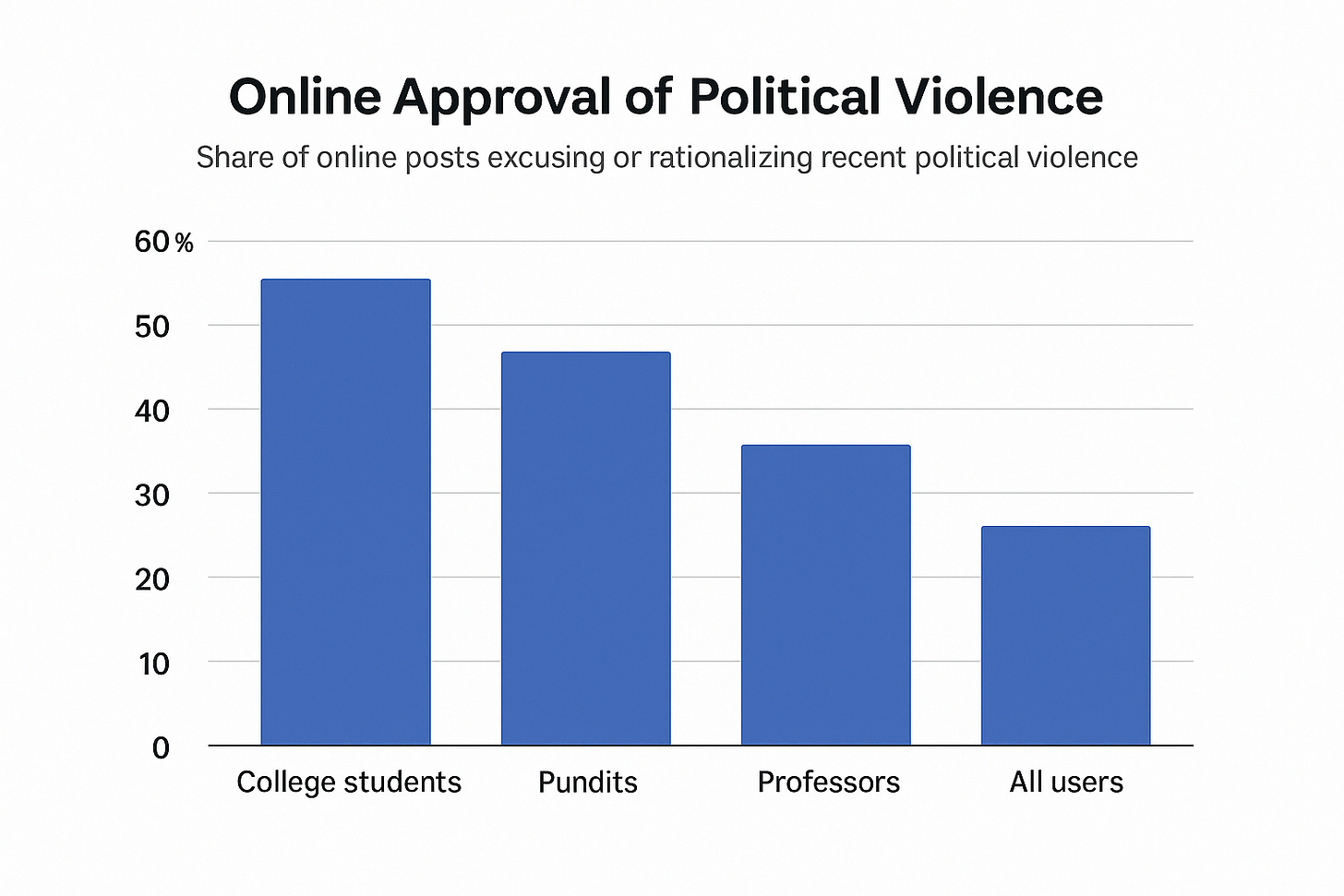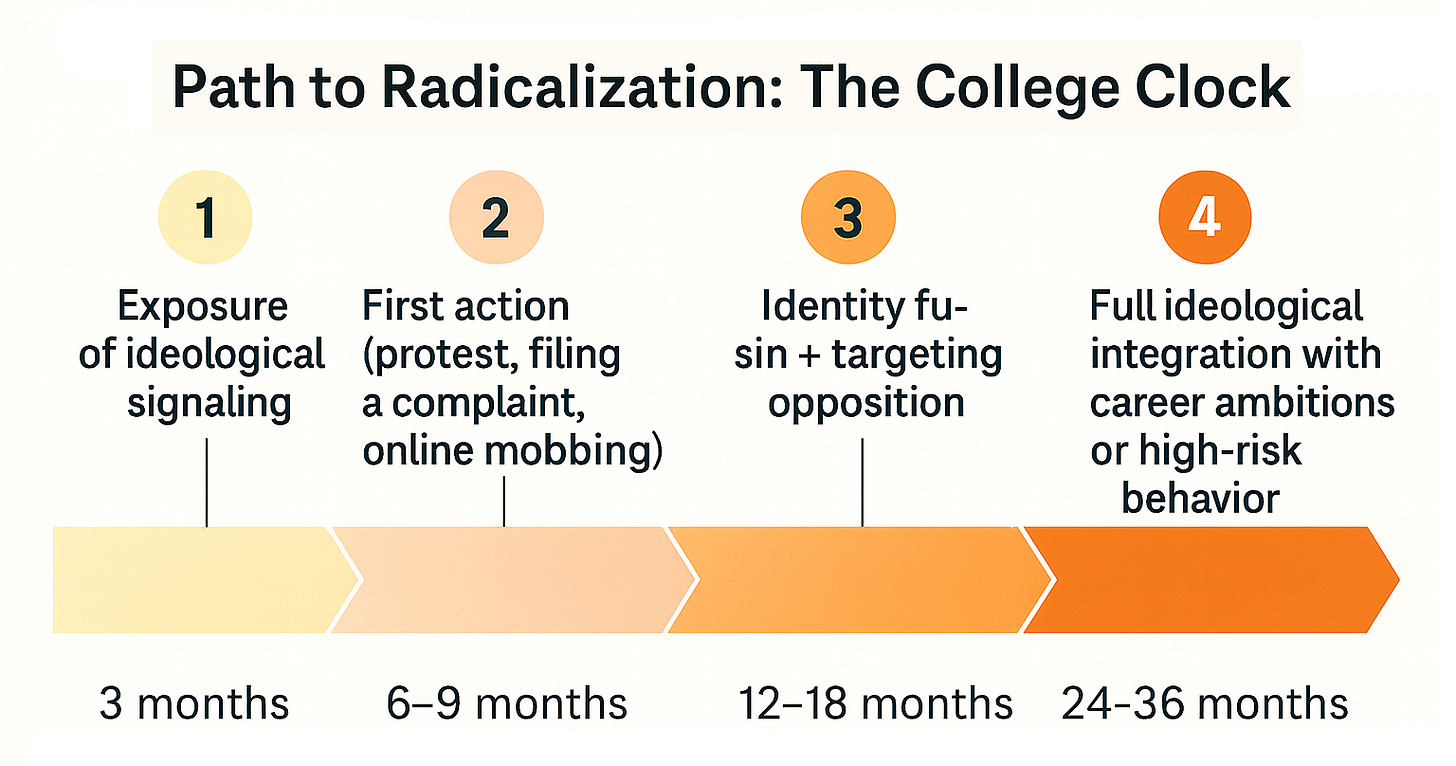The Making of a Campus Radical
The four-year indoctrination you paid for — that turned your child into a Marxist weapon.
If someone had told you ten years ago that the clean-cut teenager down the street would one day be screaming outside a campus lecture, trying to get someone fired, or worse, pulling a trigger at a political rally, you might have laughed.
But today, you check the news, and you can’t laugh because someone pulled the trigger. And your first thought isn’t confusion. It’s a prediction. Of course it happened. Because everything around us, including our media, universities, and institutions, has been pointing to it.
The radicalization of college students is not some unpredictable glitch. It’s a feature of the modern university system, the mainstream media, and the Democrat Party. And it’s time to walk through how it works, how long it takes, and what happens when it isn’t stopped.
The Campus Ecosystem
A 2023 survey by the National Association of Scholars found that over 60% of social science faculty at major universities identify as either “far-left” or “liberal.” In fields such as sociology and gender studies, that number rises to over 85%. But the numbers alone don’t capture the culture. Universities are no longer just places where ideas compete; they are incubators where one ideology receives institutional protection, budgetary support, and disciplinary enforcement.
Consider the DEI (Diversity, Equity, and Inclusion) apparatus. What used to be a part-time HR function has metastasized into a complete administrative wing at many schools. According to 2023 data from the Heritage Foundation, the University of Michigan employed 142 DEI officers, more than its entire history department faculty. These offices are not passive. They mandate training, vet campus speakers, shape hiring practices, and surveil language norms.
Combine that with peer dynamics and young adults' desperate need for approval, and you have a system where disagreement isn’t just unpopular. It’s punished. Socially, academically, sometimes even legally. The result is a kind of moral cartel: say the right thing, or pay the price.
The Ladder of Involvement (Behaviors, Not Beliefs)
The path to radicalization isn’t typically ideological at first. It’s behavioral. A freshman doesn’t show up quoting Herbert Marcuse or Karl Marx. He shows up wanting friends. He wants a tribe. He wants a sense of purpose.
So the first step is often low-cost: liking the right post, reposting a slogan, and avoiding controversial classmates. Then come the higher-cost behaviors: joining protest groups, heckling speakers, and outing classmates as problematic. By junior year, that same student might be filing Title IX complaints against professors who didn’t signal sufficient enthusiasm for the latest social movement.
By senior year, if the feedback loop is strong enough, the student no longer thinks of dissent as disagreement. It becomes a threat to justice. A threat to humanity. And when dissent becomes violence, violence becomes justified.
Freshman Fall: Exposure and Adoption
The first semester is key. Students arrive disoriented, alone, eager to fit in. Orientation sessions no longer teach them the layout of the campus. They teach them the language of power.
Terms like “microaggression,” “structural privilege,” and “lived experience” are presented as settled truths, not contested ideas. Critical Race Theory isn’t offered as just one perspective; it’s integrated into curricula across various departments. Even STEM fields aren’t immune. MIT’s School of Engineering now incorporates anti-racism modules into technical courses.
And if a student objects, even politely? They’re labeled. Isolated. Marked as unsafe. And once that label sticks, it spreads fast.
Marcuse, a mid-century Marxist thinker, believed that silencing opposing views wasn’t censorship. It was justice. That idea now runs your child’s freshman orientation.
Sophomore Shift: Hardening and Identity Fusion
Psychologists describe something called identity fusion, where a person’s individual identity becomes inseparable from a group identity. Fused individuals are not just loyal to their group. They’re willing to fight or even die for it.
This phenomenon is evident in cults, terrorist networks, and, yes, activist circles. By sophomore year, students who’ve spent a year immersed in activist culture often exhibit fused identities. They no longer say, “I support this cause.” They say, “This is who I am.”
And fused identities react violently to a threat. Even a symbolic threat. A speaker on campus doesn’t just hold a different view. He is attacking their existence. This is how you get riots at Berkeley over visiting lecturers, or mob assaults at Middlebury College when Charles Murray tried to speak. In the latter case, a female professor escorting Murray was hospitalized with a concussion.
Role Pipelines
One reason radicalism doesn’t cool off after graduation is that there are career paths that support it. Nonprofits, NGOs, media outlets, and activist groups all provide paid roles for ideologically loyal graduates.
For example, after the 2020 George Floyd protests, donations to progressive advocacy groups surged past $10 billion, according to InfluenceWatch. That money didn’t just pay for signs. It paid for staff. And many of those staffers were recent graduates who had been trained in the exact worldview the organizations promote.
This is what Thomas Sowell referred to as the self-reinforcing circle, where incentives align with ideology. You don’t just believe it. You benefit from it.
Violence-Risk Band (Rare, But Consequential)
Not every radicalized student becomes violent. But every political assassin started as a disaffected kid.
A 2022 study from the National Counterterrorism Center looked at ideologically motivated violence among young adults. It found that while violent outcomes are rare, the precursors, identity fusion, dehumanization of opponents, and moral disengagement, were common in certain activist subcultures.
And these precursors aren’t just private thoughts. They’re praised online. The student who throws soup at a painting or glues herself to a street is a hero on TikTok. What message does that send to the kid one step further down the ladder? When Charlie Kirk was assassinated, the most shocking part wasn’t just the act itself, it was how many people excused it. College students, pundits, even professors rushed to rationalize or downplay the killing. Some called it “inevitable.” Others framed it as “resistance.” When violence against political opponents is not only tolerated but applauded, the line between speech and slaughter doesn’t just blur, it vanishes.
Time-to-Spreading Hate vs. Time-to-Violence
You don’t go from “undecided major” to “domestic terrorist” overnight. But you can go from “quiet freshman” to “loud, intolerant activist” in under a year.
The median time-to-engagement in campus activism is just 3–6 months, according to a 2019 NASPA report on student political identity. Time-to-harassment (e.g., filing bias reports, mobbing speakers) tends to follow by months 6–12.
Time-to-violence? That’s rarer. However, when it happens, it’s not a disconnected experience. It’s the tail end of the same process.
And like Sowell warned in The Vision of the Anointed, the real damage often comes from the anointed few who believe they’re licensed to act, no matter the cost.
Case Study Scaffolding (Without Doxxing or Speculation)
Take Evergreen State College, 2017. A biology professor objected to a race-based campus policy and was mobbed by students, who barricaded administrators, demanded staff firings, and patrolled campus with weapons. The school lost enrollment. The professor and his wife had to flee the state.
Or Stanford Law School in 2023, where a federal judge invited to speak was shouted down by students who claimed his rulings were offensive. But the real scandal wasn’t just the protest. It was that the school’s DEI Dean stood beside the students, not the speaker, and delivered a ten-minute lecture accusing him of causing “harm.” No disciplinary action followed. The message was clear: hostility toward dissent was not only tolerated but also encouraged. It was endorsed.
Or Columbia University in 2024, when pro-Palestinian encampments took over the campus and Jewish students reported threats, the administration hesitated, afraid to act against an anti-Israel movement cloaked in social justice language.
Or UCLA in 2024, where pro-Palestinian demonstrators occupied key campus areas and barricaded Jewish students inside a library. When the students inside called for help, university security delayed response. Videos showed students pounding on the doors, begging to be let out, while protesters chanted slogans outside. No mass arrests. No academic penalties. Just another day where safety took a back seat to ideology.
These aren’t isolated incidents. They are data points. And the pattern is clear.
Clocks You Can Say Out Loud (Illustrative Ranges)
3 months: First signs of ideological signaling
6–9 months: First action (protest, filing a complaint, online mobbing)
12–18 months: Identity fusion + targeting opposition
24–36 months: Full ideological integration with career ambitions or high-risk behavior
Some reverse. Many don’t. Because the incentives don’t change.
Off-Ramps and Reversals
Not every student stays radical. Personal experience can offer a path out. Jobs. Marriage. Faith. Disillusionment. These all matter.
When radicalization is emotional, the way out is experiential. A campus activist who gets falsely accused may begin to question the machinery they helped build. A student who works with conservatives at an internship may realize that disagreement isn’t dehumanization.
But reversals are slow. They take time. And they are fragile. Because the social cost of leaving the tribe is steep. Just ask any former activist who’s now persona non grata.
Evidence Plan
To track this process, you don’t need a thought-police database. You need behavioral signals:
Who’s attending protests?
Who’s filing reports?
Who’s escalating conflict?
Who’s joining radical groups?
Then track the timing. Build anonymized cohorts. Use surveys. Watch network overlap. Validate with known case studies.
And above all: measure behavior, not beliefs.
Parent-Reader Takeaway
If you’re a parent, you don’t need to helicopter your kid’s political opinions. You need to understand the system that shapes them.
The question is not: Does my kid know right from wrong?
The question is: How long will he last in a system that rewards the opposite?
If he’s not equipped to resist it, then the answer might be: Not long enough.
And one day you may turn on the news and wonder how your well-spoken son ended up screaming at a rally or pulling a trigger.
That answer won’t be a mystery.
It’ll be the most predictable thing in the world.
This Is Where Radicalization Ends and Resistance Begins
You didn’t pay tuition for your child to become someone else’s weapon.
You didn’t raise them to hate their country, their parents, or the truth.
But that’s exactly what today’s institutions are training them to do — and calling it progress.
They rewrite history and call it justice.
They censor dissent and call it safety.
They churn out activists instead of adults — and expect you to stay quiet while it happens.
I don’t have corporate backers.
I don’t have foundation money.
But I have this platform and I have you.
If you believe in truth over ideology, in reason over rage, then now’s the time to stand up.
Become a Paid Subscriber: https://mrchr.is/help
Join The Resistance Core (Founding Member): https://mrchr.is/resist
Buy Me a Coffee: https://mrchr.is/give
Give a Gift Subscription https://mrchrisarnell.com/gift
Every click. Every share. Every dollar.
It all matters, because this isn’t just about students anymore.
It’s about the country they’ll inherit.
And whether we’re still allowed to tell the truth inside it.
I won’t back down. Will you?






Black America appreciates your willingness to put yourselves (and the Asians you dragged along) on the front lines of this all-out assault.
Chris,
In 1966 I attended UC Santa Cruz in its second year of operation. There were two colleges: Cowell and Stephenson. I enrolled as a chem major without preference and they sent me to Stevenson, which was a liberal arts college directed toward social studies, named after Adlai. Thankfully I had to live at home in the mountains and commute to classes. I was therefore isolated from the social pressures that you describe. that would have come with dorm existence.
But what I want to make clear is that the process of creating progressive liberal radicals was happening at that time. It's nothing new. The mandatory three-quarter core course at Stevenson was as follows: Brand new high school graduates were tossed into a very technical linquistics class where almost no-one could get their feet on the sand below the roiling surf, metaphorically speaking. What in hell this was all about was a mystery to me; the notation was unintelligle, the theory bizarre, and it was a total waste of time trying to survive. It was the equivalent one of the first weeks of military basic training, intended to break you down no matter how prepared you thought you were.
Then, second quarter, we had the History of the American Dream. A not-so-subtle attack on typical American values, political system, and capitalism. We read a lot of stuff written by critics of our culture that left you questioning your upbringing and what you thought was right.
Then, in spring quarter, we had the History of the Russian Revolution. Ahh, behold the glorious rise of the Proletariat.
At the time I was green and "wet behind the ears". I didn't comprehend what the purpose of this strange first year really was. Much later, after completing my first law enforcement (semi-military) academy experience, I came to realize that those bastards had tried to indoctrinate me.
But it didn't take. I did the minimum I had to do in those classes to get through, and put my energies into chemistry, physics and linear algebra, and related subjects throughout my four years there. And the science and mathematics faculty were quite neutral and straightforward in their teaching. So, I got a decent education and have remained an essentially conservative character.
Thanks for listening, and keep up the good work; but, again, it's very important to realize that where we are today with regard to most institutions of higher education is a result of paths that were established by radical socialists in the university environments long before I got to UCSC in 1966.